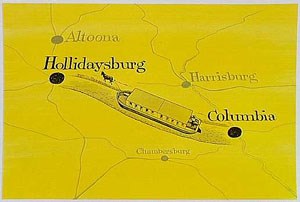
NPS/Harpers Ferry Center. The Allegheny Portage Railroad was part of the Main Line Canal. The early 1800s were a boom time for canals. Like many of the governmental projects of its day, this one was quite political. From where the canal would begin, to where the Portage Railroad ran, all were political decisions. And important ones, too. Transportation is a key to the development of many a business, town, or other enterprise. The driving force behind the creation of a canal transportation system in the Commonwealth of Pennsylvania was competition. Once the Erie Canal opened, other states began examining their resources to see how canals could benefit them. Pennsylvania was one of these states. The largest obstacle to canal building in Pennsylvania, at least for a canal running east to west, was the Allegheny Mountains. The early legislature and canal engineers considered the mountains a challenge, not a reason to give up the canal idea. The solution adopted was the Allegheny Portage Railroad. Just as its name suggested, the railroad was to portage boats from one body of water to another. The trip west on the Portage began as the boats left the canal basin at Hollidaysburg. They were taken over the mountains then returned to the canal at the basin in Johnstown. The canal system was a total of 394 miles long. It included three canal divisions as well as two railroads; the Philadelphia and Columbia Railroad and the Allegheny Portage Railroad. The canals were dug 40 feet wide at the water line, 28 feet wide at the bottom, and a minimum of 4 feet deep. Locks 90 feet long and 15 feet wide, 17 feet wide in the Eastern Division, overcame an elevation of 2,102 feet above Philadelphia and 1,691 above Pittsburgh. There were 18 lift locks between Columbia and Hollidaysburg, 66 lift locks between Johnstown and Pittsburgh. That is just the basic canal! There are also aqueducts, feeders, canal basins, waste-weirs, towing paths, bridges, and other support features that had to be built. The system was a huge undertaking. The effects were felt throughout Pennsylvania. Industries throughout the Commonwealth benefited from this transportation link. This was the era of the Industrial Revolution. Manufacturing of goods and materials was just beginning to take off. The coal to power early machines, the iron and metal to create mechanical pieces, the wool, cotton, and silk to use as raw material for fabric production, all were found in Pennsylvania. It is far too easy to discount the contributions, both today and historically, of the Commonwealth. Pennsylvania remains a top agricultural state and home of industry. There are still supplies transported on Pennsylvania rivers today. |
Last updated: December 7, 2025
